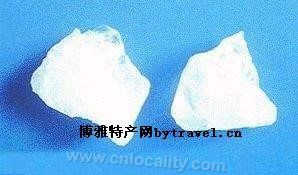welcomeSpecialty Foods Products!

Lujiang Fanshi is located in the mountains 25 kilometers southeast of Lujiang County. It is foggy in the daytime and brightly lit at night. This is one of the two famous alum production bases in China-Lujiang Fanshi. Lujiang Fanshi, a product of the Cretaceous Yanshan Movement, is 130 million years ago. Legend has it that alum was discovered by the working people in Fanshan in the Zhou Dynasty in the 11th century. In the third year of Tang Wenzong's reign (838), the Bancroft brothers pioneered the frying method to extract alum, which has been more than a thousand years. In Song Dynasty, Fanshan Mountain belonged to Wuwei Army, and the government set up Kunshan Alum Factory here to strictly control alum products. In 1083, there were 1.5 million Jin of alum courses in Wuwei Army, and the government set up officials here to collect alum at low prices and sell it at high prices, which made huge profits, and it was strictly forbidden to sell alum privately. In the Yuan Dynasty, the output of Lujiang alum occupied an important position in the total output of seven places in China, and the government also collected the most courses. According to the first year of Emperor Wenzong's calendar (1328), the quota of Lujiang alum courses had reached 2400 ingots. Lujiang alum mine declined greatly in the early Ming Dynasty and developed in the middle period, but the total amount of three alum factories ordered by the government was only 220,700 Jin, which was only one-seventh of the 1.5 million Jin of Lujiang alum mine in Yuanfeng six years in the Northern Song Dynasty. In the Qing Dynasty, the government strictly controlled it. According to Jiaqing's Lujiang County Records, "it was difficult to mine alum earlier". In the forty-sixth year of Kangxi (1707), there were "18 tents of alum kiln" in Fanshan Mountain. At that time, the government controlled villagers to mine and smelt alum, and were not allowed to interfere with graves and farmland. It is forbidden to fry in spring, summer and autumn, and it can only be fried on the first day of October in the lunar calendar and turned off on December 30. Only five kilns can be burned in one winter, and the output is very small, and the price of alum is low. "Every stone is worth two yuan and five cents", and the output value in one winter is only "six or seven thousand two hundred", so no one cares about the difficulties of kiln households. In Guangxu, it was only allowed to mine alum all year round. In the Republic of China, kiln households increased to 66. After the founding of New China, the alum mine was reborn. In 1950, a local state-owned alum factory for workers and peasants was established. In March 1956, 48 private alum factories were absorbed to form Lujiang alum mine. Now it has grown to 3,000 workers, mining 120,000 tons of alum annually, and producing more than 20,000 tons of alum. It has also vigorously developed the comprehensive utilization of alum, becoming a key enterprise of the Ministry of Chemical Industry and Anhui Province. In 1980s, the super-grade alum, the Great Pearl, was successfully trial-produced. It is famous all over the world for its bright, clean and transparent characteristics, and its products sell well in dozens of countries and regions such as Singapore, Japan, Malaysia and New Zealand.
Reprinted with attribution:
https://cnlocality.com/(Chinese Specialty Products)
other
consult:(+86)13225231905